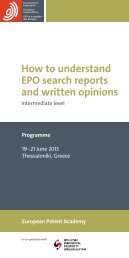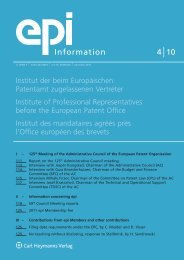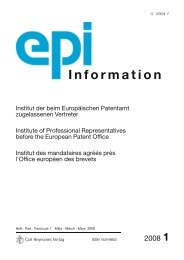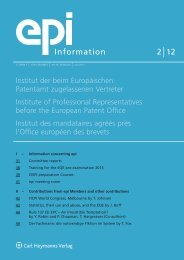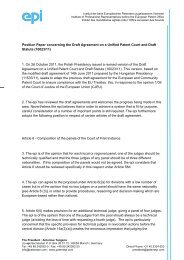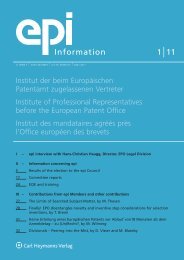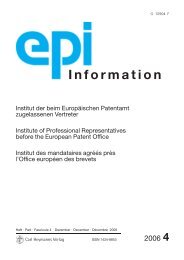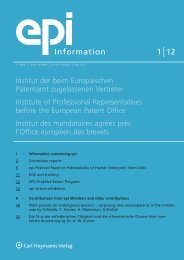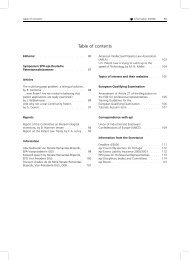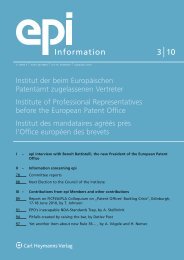epi Information 2/2009
epi Information 2/2009
epi Information 2/2009
Create successful ePaper yourself
Turn your PDF publications into a flip-book with our unique Google optimized e-Paper software.
66 Articles <strong>Information</strong> 2/<strong>2009</strong><br />
The Guidelines have two passages dealing with it: C IV<br />
7.4 and C VI 9.1.6. The latter relates to divisional<br />
applications and says that parent and divisional<br />
„may not claim the same subject-matter (see IV, 7.4). This<br />
means not only that they must not contain claims of<br />
substantially identical scope, but also that one application<br />
must not claim the subject-matter claimed in the<br />
other, even in different words. The difference between<br />
the claimed subject-matter of the two applications must<br />
be clearly distinguishable.“.<br />
The former applies this to double patenting specifically;<br />
„However, in the rare case in which there are two or<br />
more European applications from the same applicant<br />
definitively designating the same State or States (by<br />
confirming the designation through payment of the<br />
relevant designation fees) and the claims of those<br />
applications have the same filing or priority date and<br />
relate to the same invention (the claims conflicting in the<br />
manner explained in VI, 9.1.6), the applicant should be<br />
told that he must either amend one or more of the<br />
applications in such a manner that they no longer claim<br />
the same invention, or choose which one of those<br />
applications he wishes to proceed to grant.“.<br />
No authority is given for this requirement, but at least<br />
there is a definition there. Interestingly the recently<br />
updated Guidelines 9 have remained completely<br />
unchanged in this respect and do not mention decision<br />
T 587/98 which seems to have taken a much more liberal<br />
view.<br />
Two legs of the definition present problems. „Same<br />
applicant“ will have to be strictly interpreted – see J 2/01<br />
applying Article 118 – and so the addition of an applicant<br />
will get outside it; more seriously, the prohibition against<br />
claiming „the same invention“, if as defined in C IV 7.4<br />
leads to anomalies. 10<br />
Consider the case of an applicant who makes a first<br />
application and then, before publication, a second, not<br />
claiming priority from the first and differing from it only<br />
in some trivial detail. Provided that detail is included in an<br />
otherwise identical main claim of the second application<br />
it will proceed legitimately to grant; it has bare novelty as<br />
required by Article 54(3). Are these not „claims of<br />
substantially identical scope“? And the further requirement<br />
that the „subject matter“ claimed in one must not<br />
also be claimed in the other is also met since one includes<br />
the other.<br />
Remembering that we were discussing applications of<br />
different date where Article 54(3) requires a distinction<br />
between them and that in the case of double patenting<br />
there is no such requirement in the Convention, what is<br />
the reason that there should be equally – or perhaps<br />
more – onerous conditions when there is identity of date<br />
than when there was prior art? 11<br />
9 Version April <strong>2009</strong>, see www.epo.org<br />
10 Using the wording „same invention“ in the Guidelines implies a very narrow<br />
interpretation along the line of G2/98.<br />
11 See T587/98 reasons 3.4 discussed above. 12 Reasons 3.2.<br />
A further serious problem if we adopt the Board’s<br />
point of view is which two claims have to be compared<br />
with each other and at which moment in time. In T<br />
307/03 the later claims put forward in the divisional<br />
application are compared with the claims as initially<br />
granted for the parent application (B1 publication).<br />
The Board indicated that they would maintain the<br />
double patenting objection even if the parent patent<br />
were abandoned. 12 When trying to avoid double protection<br />
shouldn’t one rather compare with the version as<br />
finally maintained (B2 publication)? Or maybe with the<br />
version after a limitation proceeding? As a matter of fact<br />
it seems impossible without making an unacceptably<br />
arbitrary choice to define which claim is to be compared<br />
with which. The whole discussion of double protection<br />
should be left to when a question of infringement or<br />
revocation is before a national court as only then there is<br />
the possibility of assessing whether indeed there is<br />
double protection, and if there is, what action should<br />
be taken.<br />
Decision T 587/93 if it is correct (as we submit it is)<br />
throws doubt on the correctness of the Guidelines C IV<br />
7.4 since protection was given to the same subjectmatter<br />
(the narrower claim) in two patents, and of C VI<br />
9.1.6 where it is said that one application „must not<br />
claim the subject-matter claimed in the other, even in<br />
different words“.<br />
Referring to Figure 1 the possible relations between a<br />
main claim of the parent (solid line) and of the claim put<br />
forward in a divisional or other „double application“<br />
(dotted line) are discussed. So in a) parent and divisional<br />
claim essentially the same subject matter, in b) the claim<br />
in the parent encompasses the divisional, in c) the claim<br />
later put forward in the divisional encompasses the claim<br />
in the parent, in d) there is partial overlap and in e) the<br />
claims are disjunct.<br />
Figure 1: schematic representations of possible relationships<br />
between claims of a parent (solid line) and of a<br />
divisional (dotted line)<br />
It seems that only in scenario a), where essentially the<br />
same invention is claimed in the divisional, a refusal of<br />
the application would be appropriate if we interpret the<br />
Guidelines in the light of decision T 587/98.<br />
According however to the new decision T 307/03 it<br />
seems that not only scenario a) would be prohibited but<br />
certainly also c), as this is the situation of the second<br />
auxiliary request which was refused entry into the<br />
appeal. So a case c) where the claim of the divisional



